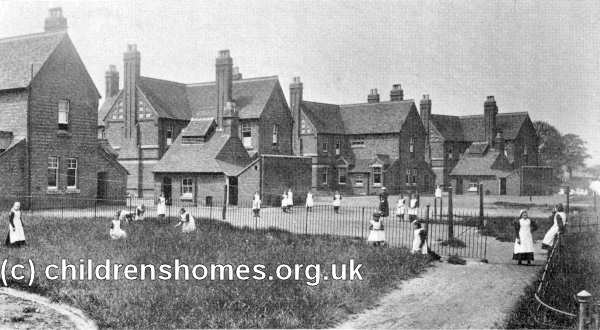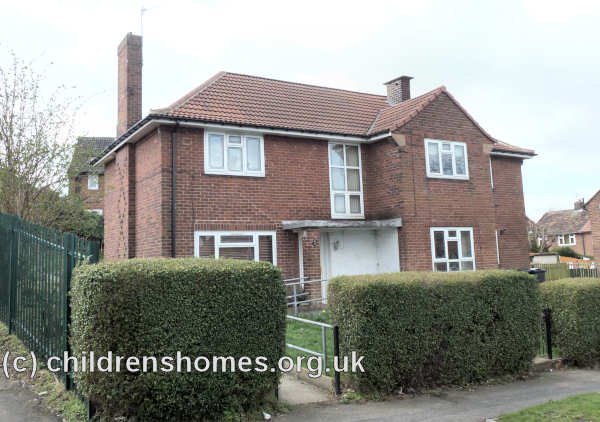Council / Local Authority Homes
The Boards of Guardians who had administered the poor relief system in England and Wales since 1834 were abolished in 1930. Responsibility for what then became known as Public Assistance was taken over by county and county borough councils. This included the management of the various children's institutions previously run by the Guardians such as District Schools, cottage homes and scattered homes.

The Wednesfield Cottage Homes taken over by Wolverhampton Council in 1930. © Peter Higginbotham
In many cases, these existing establishments continued in operation along the same lines as they had prior to 1930. Some new homes were also opened and old homes closed. During the Second World War, homes in danger of enemy bombing were moved to safer locations. In Sheffield, for example, children from the city council's children's home at Herries Road were evacuated to Thornseat Lodge, a large house in an isolated location at the edge of the Peak District.

Thornseat Lodge, Higher Bradfield, 2013. © Peter Higginbotham
In 1946, the Curtis Report into institutional children's care recommended that, wherever possible, children who lacked a normal family home should be placed for adoption or with foster parents. Residential care was to be the least preferred option and, if needed, should be in small family-group units, ideally with no more than eight children. This new approach was formalised by the 1948 Children Act, under which councils were required to provide care services for all needy children in their area. In order to carry out this task, each council established a new Children's Committee and appointed a Children's Officer. In addition to children's homes, the responsibilities of the Children's Committees also included council-run Approved Schools and Remand Homes.
Despite the use of residential care being discouraged, many councils found that they needed to expand their stock of children's accommodation. Initially, in the late 1940s and early 1950s, the quick solution to this was to purchase one or more properties, usually good-sized detached houses with large gardens, which typically accommodated around twenty children. During the 1950s, however, councils increasingly placed smaller, purpose-built, family-group homes on the housing estates that were being erected on the outskirts of many towns and cities. These homes usually housed eight or ten children under the care of a house mother, and were very much in line with the type of accommodation recommended by the Curtis Report.

Leeds Family Group Home erected 1956. © Peter Higginbotham

Leeds Family Group Home interior, 1950s.
From the 1960s onwards, many local councils were affected by periodic reorganizations of local government and the areas that they served. In 1964, responsibility for children's services in London began to be transferred from the Greater London Council to twenty-eight London Borough Councils. In the same year, Luton and Solihull became county boroughs. In 1968, the county borough of Teeside was created around the urban area of Middlesbrough. More widespread changes came in 1974 with the creation of new counties, such as Teesside, Humberside, and Hereford and Worcester, while cities such as Bristol, Hull, Leicester, Nottingham and Derby became unitary authorities having no lower-tier district councils. The 1974 reforms particularly affected Wales, where the thirteen historic counties were replaced by eight new administrative counties. Further changes in 1996 included the reversal of some of the 1974 creations, such as the re-separation of the Hereford and Worcester county councils, and the creation of 22 'principal areas'. As far as children's homes were concerned, the main effect of the changes was that some homes transferred to the management of a different council, sometimes on more than one occasion.
Since the 1980s, there has been a growing trend for councils to buy in child care services rather than running them themselves. At the present time, around 19 per cent by councils of children's residential care places are directly provided by councils, and around six per cent by the voluntary sector. The bulk, about 75 per cent, are now provided by the private sector.
Records
Note: many repositories impose a closure period of up to 100 years for records identifying individuals. Before travelling a long distance, always check that the records you want to consult will be available.
The involvement of local authorities in the running of children's homes dates from 1930, when they took over the running of the poor relief system previously administered by Boards of Guardians. Surviving records for council-run children's homes may be held in each council's own internal archives. Prior to 1991, however, when a legal requirement was introduced for councils to retain records of children leaving their care, the survival of such records is very variable. Contact details for local authorities in the UK can be found on the website of the Care Leavers Association (CLA). The CLA also provides guidance on accessing childhood care files, which are normally only open to the individuals they relate to.
Locating local authority records has been complicated by the various local government reorganizations that have taken place in recent times, such as the abolition of the London County Council in 1965, and the major nationwide restructuring in 1974 in which many administrative areas were created, amended or eliminated.
Older records may sometimes be placed with the relevant county or borough record office. Many of these repositories have online catalogues of their holdings and also contribute to the National Archives' Discovery database. Note that records containing personal data usually have access closed for a period of fifty years or more.
Bibliography
- Higginbotham, Peter Children's Homes: A History of Institutional Care for Britain s Young (2017, Pen & Sword)
Links
- www.workhouses.org.uk — The Workhouses Website
Except where indicated, this page () © Peter Higginbotham. Contents may not be reproduced without permission.


